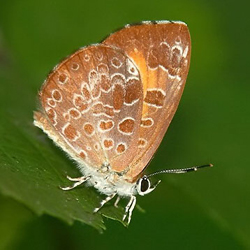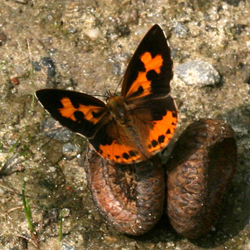Find a Butterfly
Harvester
Feniseca tarquinius
Named
Fabricius, 1793

Identification
Wingspan: 1 1/8-1 1/4". Irregular orange markings above with dark brown borders and spots; below much paler; hindwing light purplish brown with pattern of open white circles. This combination of characters is unique. Unlikely to be confused with other lycaenids: elfins are much darker, coppers are black spotted beneath.
Distribution
Southeastern Manitoba east to Nova Scotia and south to eastern Texas and central Florida. The species is a member of a small group of butterflies which, besides this sole North American representative, occurs only in Old World equatorial regions.
Status in Massachusetts
The Harvester was not a well known insect in Scudder‘s day and its status remains enigmatic today. Scudder noted the Connecticut Valley as the single Massachusetts locality, while Farquhar (1934) listed eighteen localities and called the species "very local". During the atlas, Harvesters were found from the southern Berkshires to Norfolk County. None were recorded from northwestern or southeastern Massachusetts. The true distribution in the state is perhaps much greater, but the butterfly requires special search efforts and was quite possibly overlooked. It populations are known to fluctuate markedly from year to year. Usually found in small numbers; one to three individuals. Maximum: 7 on 19 August 1988, South Hadley (Hampshire Co.).

Flight Period in Massachusetts
Multiple brooded; probably three or four flights, but exact number of broods undetermined. Adults are on the wing from May until October. Extreme dates: 4 May 1991 and 6 November 1988, Millbury (Worcester Co.), T. Dodd.
Larval Food Plants
See Life Cycle.
Adult Food sources
Honeydew from aphids.

Habitat
Alder swales primarily. Also, nearby glades and roadsides.
Life Cycle
EGG: Light green; flattened dome shape; "remarkable for the great number of cells which cover the surface" (Scudder, 1889). OVIPOSITION: Eggs are laid singly, among or near colonies of wooly aphids, usually on the undersurface of a twig. LARVA: Glaucous colored, wide and rounded at both ends: body covered with long hairs. CHRYSALIS: Brownish, and shaped like a monkey‘s head.
Upon hatching, the larva crawls beneath the mass of wooly aphids and spins a silken shelter. It then begins its remarkable larval development, as a carnivore! From the security of its niche beneath the aphids, it feeds upon the succulent insects, camouflaging itself with "wool" scales from the victims. The larva must remain hidden, since the aphids are normally "farmed" by ants for their honeydew, and the ants may attack and kill an exposed larva. Larval development is swift, as is that of the monkey faced pupa, and three weeks from the time the egg was laid, the adult Harvester emerges. This cycle repeats itself perhaps two or three times during the summer and fall. There is still some question about how the Harvester overwinters. In Massachusetts, it likely overwinters as either a partially developed larva or a pupa.
The adult has an extremely short proboscis and eschews flower nectar, instead taking aphid honeydew and occasional moisture at mud puddles.
Notes
Easiest to find as a larva, when it can be discerned as a "bump" in the midst of a wooly aphid colony. Larvae are easily reared if provided with an adequate supply of aphids. An encounter with the Harvester by Austin Clark of U. S. National Museum says something about the scarcity of this species and the eccentricity of the lepidopterist species! "This insect is rare in eastern Massachusetts and, though I collected constantly in that region for a number of years, I was never able to capture a specimen...I noticed, on July 25, 1910, a single specimen flying low over the lawn of the house at the southwest corner of the intersection of Lowell and Highland Avenues, Newtonville. Seizing the hat from the head of a child which was playing nearby, I succeeded, with this substitute for a net, in capturing it."
Account Author
Brian Cassie



